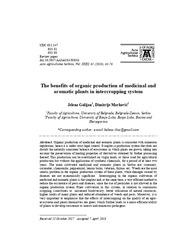Приказ основних података о документу
The benefits of organic production of medicinal and aromatic plants in intercropping system
Značaj združenih useva u organskoj proizvodnji lekovitog i aromatičnog bilja
| dc.creator | Golijan, Jelena | |
| dc.creator | Marković, Dimitrije | |
| dc.date.accessioned | 2020-12-17T22:27:08Z | |
| dc.date.available | 2020-12-17T22:27:08Z | |
| dc.date.issued | 2018 | |
| dc.identifier.issn | 0354-9542 | |
| dc.identifier.uri | http://aspace.agrif.bg.ac.rs/handle/123456789/4882 | |
| dc.description.abstract | Organic production of medicinal and aromatic plants is consistent with numerous regulations; hence it is under strict legal control. It implies a production system that does not disturb the naturally consistent balance of ecosystems in which plants are grown, taking into account the preservation of healing properties of derivatives obtained by further processing thereof. This production can be established on virgin lands, or those used for agricultural production but without the application of synthetic chemicals, for a period of at least two years. The main cultivated medicinal and aromatic plants in Serbia are: rosemary, coriander, chamomile, peppermint, lemon balm, valerian, thyme, etc. Weeds are the most serious problem in the organic production system of these plants, while damages caused by diseases are not economically significant. Intercropping in the organic cultivation of medicinal and aromatic plants is the simplest and, at the same time, a very efficient method to reduce the occurrence of pests and diseases, since the use of pesticides is not allowed in the organic production system. Plant cultivation in this system, in relation to continuous cropping, contributes to increased biodiversity, better utilisation of natural resources, higher yields of many plants and reduced abundance of weeds and pests. Moreover, it is very important to emphasise that the effects of intercropping on the quality of an agroecosystem and plants themselves are great, which further leads to a more efficient ability of plants to develop resistance to insects and numerous pathogens. | en |
| dc.description.abstract | Organska proizvodnja lekovitog i aromatičnog bilja usklađena je sa brojnim regulativama, te se nalazi pod strogom zakonskom kontrolom. Podrazumeva takav sistem proizvodnje koji neće narušiti prirodno usklađenu ravnotežu ekosistema u kome se bilje gaji, vodeći pritom računa o očuvanju lekovitosti derivata koji se dobijaju daljom preradom istih. Organska proizvodnja lekovitog i aromatičnog bilja može se zasnivati na devičanskim zemljištima ili zemljištima iz poljoprivredne proizvodnje na kojima nije bilo upotrebe sintetičkih hemikalija u periodu od najmanje dve godine. Među gajenim vrstama lekovitog i aromatičnog bilja u Srbiji, najveću proizvodnju zauzimaju ruzmarin, korijander, kamilica, nana, matičnjak, valerijana, majčina dušica, a od samoniklih vrsta kantarion, hajdučka trava, žalfija, kleka, lovor, smilje, bor i druge vrste. Najveći problem u organskom sistemu proizvodnje ovog bilja predstavljaju korovi, dok bolesti ne čine ekonomski značajne štete. Primena združenih useva u organskom uzgoju lekovitog i aromatičnog bilja najjednostavniji je, a pritom veoma efikasan način da se redukuje pojava štetočina i bolesti, s obzirom na to da u organskom sistemu proizvodnje nije dozvoljena upotreba pesticida. Uzgojem biljaka u ovom sistemu, u odnosu na monokulturu, povećava se biodiverzitet, bolje se iskorišćavaju resursi iz prirodnog okruženja, povećava se prinos mnogih biljaka, smanjuje brojnost korova i štetočina, a takođe, što je veoma bitno istaći, združeni usevi imaju veći uticaj na kvalitet agroekosistema i samih biljaka, što dalje utiče na efikasniju sposobnost biljaka u stvaranju otpornosti prema insektima i mnogim patogenima. | sr |
| dc.publisher | Univerzitet u Kragujevcu - Agronomski fakultet, Čačak | |
| dc.rights | openAccess | |
| dc.rights.uri | https://creativecommons.org/licenses/by/4.0/ | |
| dc.source | Acta agriculturae Serbica | |
| dc.subject | organic production | en |
| dc.subject | medicinal and aromatic plants | en |
| dc.subject | legislation | en |
| dc.subject | intercropping | en |
| dc.subject | organska proizvodnja | sr |
| dc.subject | lekovito i aromatično bilje | sr |
| dc.subject | združeni usevi | sr |
| dc.title | The benefits of organic production of medicinal and aromatic plants in intercropping system | en |
| dc.title | Značaj združenih useva u organskoj proizvodnji lekovitog i aromatičnog bilja | sr |
| dc.type | article | |
| dc.rights.license | BY | |
| dc.citation.epage | 76 | |
| dc.citation.issue | 45 | |
| dc.citation.other | 23(45): 61-76 | |
| dc.citation.rank | M51 | |
| dc.citation.spage | 61 | |
| dc.citation.volume | 23 | |
| dc.identifier.doi | 10.5937/AASer1845061G | |
| dc.identifier.fulltext | http://aspace.agrif.bg.ac.rs/bitstream/id/3394/4879.pdf | |
| dc.type.version | publishedVersion |


